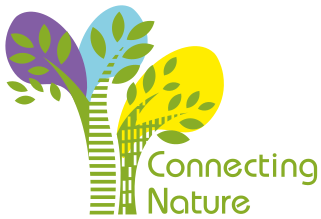
Image: Martha Healy, ever curious about nature, enjoys the newly created spiral garden at her home.
No Fauna Have Been Harmed in The Making of These Gardens.
Growing up, we lived within cycling distance from ‘Organic Delights’, one of Irelands longest established organic food farms, run by Denis Healy in Wicklow. I worked there in the summers as a teenager. By osmosis, I came to understand the interconnected systems of soil, water and seasons at play, in this age-old method of working with nature to grow food. This understanding of interconnectivity still inspires my nature-based landscape architecture practice today.
What are Nature-Based Solutions?
Nature-based solutions, (NBS) according to the UN can contribute by up to a third of solutions to our adaption and mitigation of the twin crisis of our time, biodiversity loss and climate change. The EU has defined NBS as “solutions that are inspired and supported by nature, which are cost-effective, simultaneously provide environmental, social and economic benefits and help build resilience. Such solutions bring more, and more diverse, nature and natural features and processes into cities, landscapes and seascapes, through locally adapted, resource-efficient and systemic interventions."[1] In 2019 at the UN Summit for Climate Action, 70 governments supported the launching of a Nature-Based manifesto, and 196 initiatives and best practice examples were contributed for dissemination.[2]
Nature-based solutions must benefit biodiversity and support the delivery of a range of ecosystem services. There should be Co-benefits for people, such as access to nature for wellbeing, for example by providing shortcuts for non-motorised travel along well-designed river corridors. Garden and Landscape designers in collaboration with our clients are well placed to design and implement nature-based solutions at different scales.
The EU Horizon 2020 project Connecting Nature[3] argues that ideally, NBS “uses a comprehensive co-design and co-creation of ideas process, with strong innovation possibilities, leading to multiple ecological, environmental and social gains.”
Organic processes contribution to interconnected Earth systems
In 2018, I was delighted to be invited by Denis to design gardens for his family. We share the same ethos to work with and be inspired by nature. With Denis, the work became a collaborative process of design with the Healy family, and the gardens became a more precious, living project for that. We wanted to create a set of six gardens with different characteristics but a common theme of good for nature as well as being beautiful vibrant places to enjoy.
For the planting, Denis introduced me to Gert Stam, Caherhurley Nurseries, who is, as far as I know, one of Ireland's only organic nurseries specialising in perennial plants. Gert is a master plantsman with a lifetime of experience in creating beautiful planting plans and gardens. His perennials are especially adapted for Irish climate.
When we, as designers, specify organic plants, we are saying no fauna have been harmed in the making of this garden. No pesticides or herbicides have been used by the nursery practitioners before the plant comes to our garden. Put simply this means the microfungal life below ground can do its thing, and there are no chemical sprays to kill invertebrate of other pests, no excess nitrates or phosphorus going into our water or soil systems. The organic grower is giving back to the soil health rather than depleting it over time. We, as Landscape and Garden Designers, can aspire to do the same.
Ursula von der Leyen, President of the European Commission, is cited on the official page of the EU Biodiversity Strategy for 2030[4] "Making nature healthy again is key to our physical and mental wellbeing and is an ally in the fight against climate change and disease outbreaks. It is at the heart of our growth strategy, the European Green Deal, and is part of a European recovery that gives more back to the planet than it takes away."
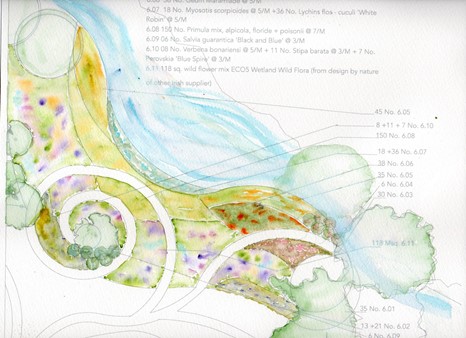
Image: Abstract from Stream Edge Planting Plan. The matrix of habitats gave us the chance to respond with different planting which would thrive in local conditions and enrich the experience for Denis’s family and friends.

Image: Healy Garden woodland planting plan.
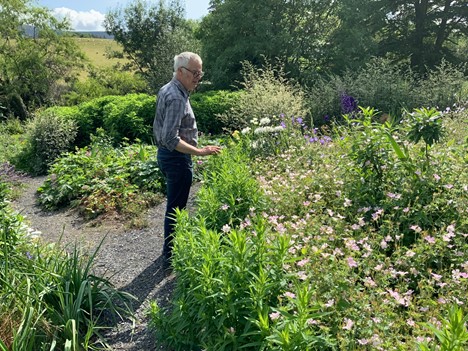
Image: Denis in the spiral garden, enjoying the vibrancy of the planting.
I visited Denis in the summer of 2019, just a year after planting to the Spiral + Hidden gardens. We saw so many species of bee and butterfly, heard a great number of birds. Denis and family have gone on to plant a field opposite the Spiral Gardens fully up with Phacelia. You can literally hear it buzzing. It lifts the heart to be in these gardens.
Collaboration approach and Co-Design
In any landscape design, whether public or private, my practice looks for opportunities to create a meaningful collaborative approach to design. With local authority clients, in particular, we have found this approach enriches the process and the chances for long term viability of the garden or public space by instilling a strong sense of community ownership.
In Herzog Park, Nature Play Area, with Dublin City Council, we created a set of three workshops themed ‘Help Nature & Have Fun in Herzog Park.’ Creating a process where it was clear to the children their voices mattered, they demonstrated a very high capacity to contribute to the design process.
Our first workshop was themed around 'Big Ideas’ exploring through free sketching on scrolls how we could play and what we could do for nature.
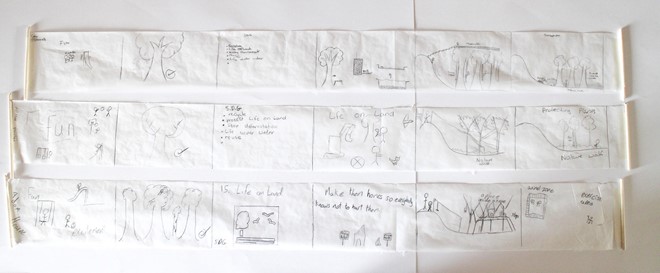
Image: Children’s work where they answered questions through drawing quickly in a fun way to questions. This way we could capture all of the seventy-five children’s ideas.
In the second, we visited the uniquely sloped site, which is a mature pocket woodland with beech, ash and sycamore trees. The children were asked to ‘Draw what you see, and what could be’ on postcards. In our final workshop, we put our ideas to together, now that we were all thoroughly familiar with the nature of the site.
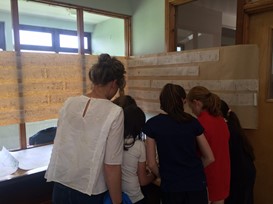
Image: Exhibition of children’s work and the indicative plans for Natural Play Area, which were inspired by the co-design process.
It became quickly clear that the children had very high environmental awareness. They demonstrated how the new nature play area could contribute to achieving the Sustainable Development Goals (SDGs), such as; SDG 12. Responsible Consumption and Production, SDG 13. Climate Action, SDG 14. Life on Water + SDG 15. Life on Land.
We displayed the children’s work in an exhibition while also revealing the indicative plans created for the Play Area.
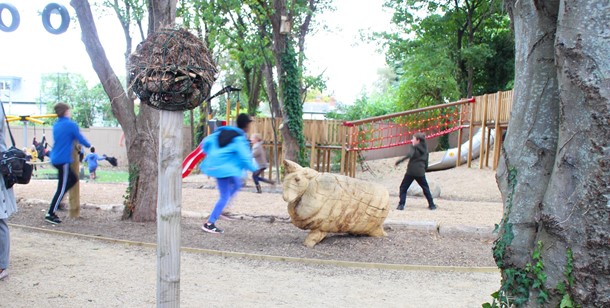
Image: Play Area opening. The wooden sheep ‘Joshua’ is bespoke designed based on a dream of one of the children. Joshua comes and rescues everyone from a tsunami.
When the park opened in September 2018 and the children rushed in after speeches and ribbon cutting. It was very clear they had a feeling full ownership and agency based on their investment and contribution to the play area’s creation. It was a very memorable moment.
We are transitioning to understand and build on our agency to help nature.
Mary Robinson has said she finds a glimmer of hope for the future of humanity on Earth by us realising in COVID 19 our personal and governmental agency to get through the crisis together. While the pandemic dangers are immediate to us, the degradation of our Earth systems is a slower danger. It’s harder to see. We might even find it depressing or frightening if we take a long view. What I think we collectively are beginning to realise is our agency to contribute to sustainable harmony with our Earth.
Nature-based Landscape Architecture is grounded in the movement of nature-based solutions which are multifunctional and interconnected. By thinking globally, and acting locally, we do have agency, and every choice matters now. How we chose to design together, in collaboration with our clients and stakeholders can assist the wellbeing of our Earth’s interconnected systems. No matter what size our garden or land. As we create, rather than thinking in terms of nature/man divide, we can think of nature's interconnection with humanity. We can decide to design landscapes which offer the possibility for people to connect with nature, building our collective agency to care for our Earth.
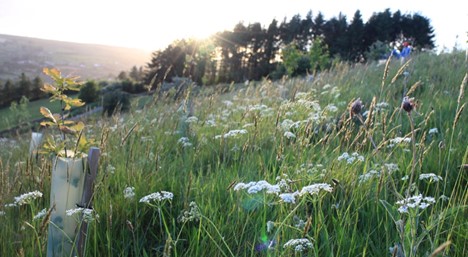
Image: The nature reserve at our home in Meelin. In the distance, a simple wooden platform where we sit and enjoy being present in nature. Providing opportunities for people to connect with nature is fundamental to the practice ethos.
[1] https://ec.europa.eu/research/environment/index.cfm?pg=nbs
[2] https://www.unenvironment.org/nbs-contributions-platform
[3] https://connectingnature.eu/nature-based-solutions-explained
[4] https://ec.europa.eu/environment/nature/biodiversity/strategy/index_en.htm
